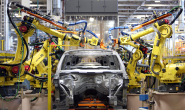Steel Markets

Wolfe Research Forecasts Better Year for Auto, Long-Term EV Boom
Written by Tim Triplett
January 10, 2022
After disappointing years in 2020 and 2021, the auto industry and its suppliers stand to enjoy a considerably better year in 2022, said Rod Lache, managing director and automotive analyst with Wolfe Research. “We think in the U.S. there are at least 10 million units of undersupply in the market, which represents pent-up demand and is very bullish for the future.”
![]() Speaking during Wolfe Research’s 2022 State of Steel webinar last week, Lache noted that global auto production experienced a recession-like year in 2020 due to the coronavirus, followed by a no-growth year in 2021 due to the lingering virus crisis and a worldwide shortage of semiconductors. Industry data at the outset of 2022 shows vehicle prices rising sharply, reflecting pent-up demand and high levels of disposable income among American consumers.
Speaking during Wolfe Research’s 2022 State of Steel webinar last week, Lache noted that global auto production experienced a recession-like year in 2020 due to the coronavirus, followed by a no-growth year in 2021 due to the lingering virus crisis and a worldwide shortage of semiconductors. Industry data at the outset of 2022 shows vehicle prices rising sharply, reflecting pent-up demand and high levels of disposable income among American consumers.
Vehicle inventories are extremely low, down from 4 million to 1 million units or just a 30-day supply. Inventory rebuilding stands to add substantially to vehicle demand this year, he said.
The production turnaround will lag until sometime later this year, however, as the industry remains constrained by the shortage of microchips. The semiconductor industry has made major capex investments to boost chip production, but not necessarily for the older legacy chips favored by the automakers. Because it takes a year to bring new chip capacity online, and because there’s competition for the chips from other industries, it’s difficult to estimate when automotive will have all the chips it needs. But vehicle production should return to more normal levels by 2023, Lache predicted.
Consumer demand for electric vehicles is poised to skyrocket as the cost of batteries comes down. Five years ago the cost of the battery pack alone was around $25,000 for an EV with a decent 300-mile range. The cost to power an EV is expected to reach parity with internal combustion engine (ICE) vehicles within the next few years and to get even cheaper than ICEs in 2030 and beyond, Lache said.
Automakers have spotted the trend and are making massive investments in EV production, with a proliferation of new models on the drawing board. EVs will represent half the volume of some car companies by the end of the decade. GM specifically has said its product line will be 100% EV by 2035.
“The trajectory of EV demand in places like Europe and China is basically going vertical. And demand would have been even higher if the industry had been able to meet it. The backlogs are just extraordinary. The consumer has clearly caught onto this,” Lache said.
What could hold this juggernaut back? Not the batteries, as one might expect, Lache said. Wolfe estimates the global industry will have enough battery-making capacity to support 50 million EVs a year by 2025 and 80 million by 2030. It’s the commodity supply chain supporting the battery makers that could prove to be the bottleneck, he said. Nickel, for one, could be in short supply.
What does all this mean for steel in the U.S.? Wolfe projects 14.7 million vehicles will be produced in 2022, up from about 13 million last year. At one ton per vehicle, that will translate to roughly 1.5 million tons of incremental steel consumption this year, not counting steel already in automakers’ inventories and “build-short” vehicles awaiting microchips. The outcome of the competition between steel and aluminum for the greatest share of the burgeoning EV market “is TBD,” Lache added.
By Tim Triplett, Tim@SteelMarketUpdate.com

Tim Triplett
Read more from Tim TriplettLatest in Steel Markets

Hot-rolled coil buyers continue seeking certainty
Steel market participants contend that buyers will remain in “wait-and-see" mode until some market stability is restored.

Latin American steel advocates warn on cheap import flood
Subsidized Chinese steel imports and cheap steel products from Association of Southeast Asian Nations (ASEAN) entering Latin American (LATAM) are threatening the region's steel market.

CRU: Steel prices fall amid global demand weakness
The forceful headwinds bearing down on steel markets across the globe have created demand challenges and sent prices southward. The US, however, challenged the global trend.

Hot-rolled price hikes garner mixed reactions from the market
Several steel market sources say they were blindsided when mills increased spot prices for hot-rolled coils this week.

Steel market participants mull the impact of US/Mexico S232 negotiations
Steel market participants learned that negotiations between the US and Mexico include discussions about Section 232 tariffs on steel and aluminum despite President Trump’s June 3 proclamation increasing the tariffs from 25% to 50% for all steel and aluminum imports—except for those from the UK.
